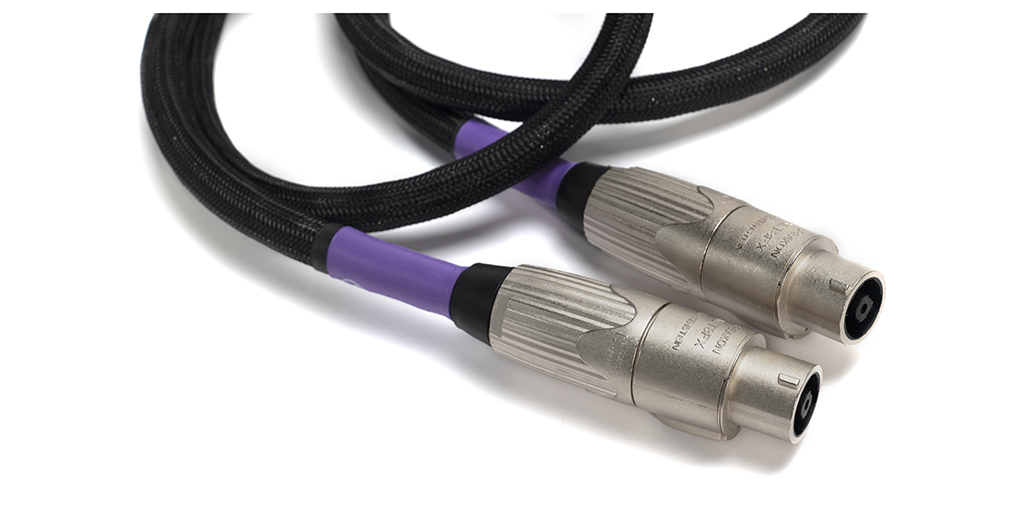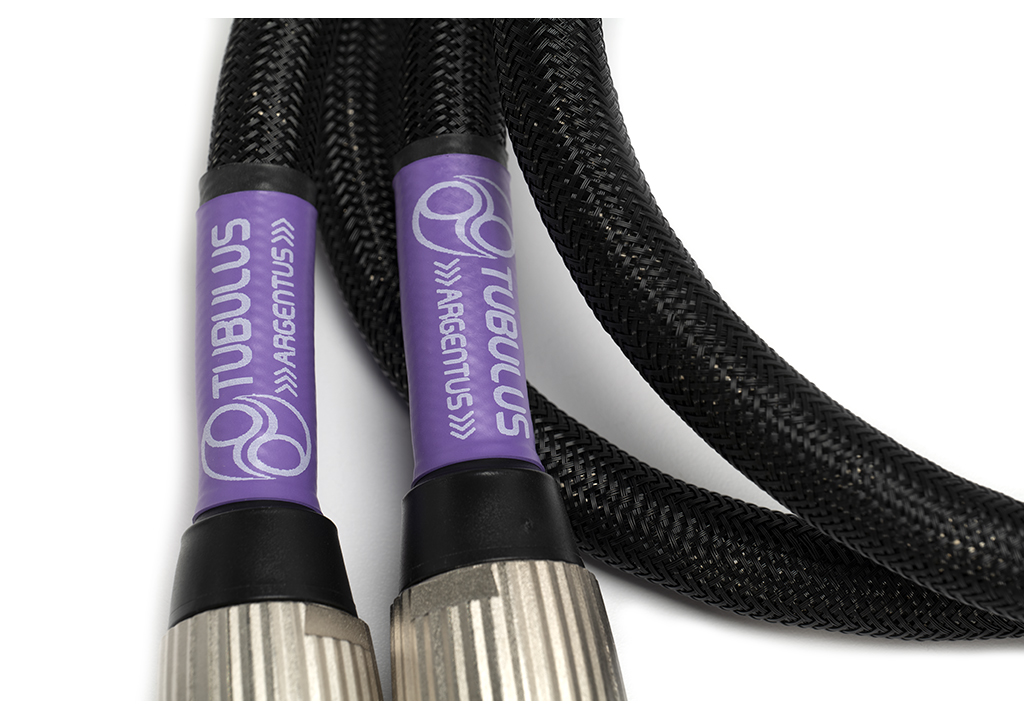Tubulus XS Umbilical Cables A Major Update to Your Pass XS System
By Jeff Dorgay and Lawrence Devoe Damn, the Bee Gees never sounded this good. If you don’t like reading cable reviews, and you have a Pass Labs XS component (or a few) just buy the Tubulus Argentus XS Umbilical Cables for your system right now. Then come on back to the review after you’ve installed them and see if you agree with us.
Damn, the Bee Gees never sounded this good. If you don’t like reading cable reviews, and you have a Pass Labs XS component (or a few) just buy the Tubulus Argentus XS Umbilical Cables for your system right now. Then come on back to the review after you’ve installed them and see if you agree with us.
In a high-performance audio system, everything matters. And everything has the potential for change, sometimes good, sometimes not. I have a bias against cable and cable reviews. I have found a few things that work well in my three systems and I use them with good result. (Cardas, Nordost and Tellurium Q) I’d rather go get a COVID test than write a cable review, because it’s so tough to quantify, and it seems to make way more people mad than it does happy. So you know we aren’t a cable of the month magazine.
Ok, deep cleansing breath.
Tubulus makes a wide range of cable, but the ones that really struck my fancy are their XS Umbilical cables that go between Pass Labs XS series components. (they also make umbilical cables for the XP series) While I no longer have the XS300 monos in my reference system, I do use the XS Pre and XS Phono, so I’m going to have to get staffer Lawrence Devoe to try a pair in his XS150 monos. I’m going to stick my neck out and be surprised if he isn’t super impressed.
However, in the case of the Argentus umbilical, this has been the easiest cable review I’ve ever done. The XS Pre and XS Phono are never powered down, so it was easy to shut one power supply off, do a quick cable swap and be back up and running. I seriously doubt we lost much thermal stability from being powered down for 90 seconds.
Quiet drama
While some of the online cognoscenti make outrageous claims for and against various cables, some of which cost as much as a nice pre-owned BMW M4, the Tubulus umbilicals offer out of this world value. At about $800 USD, in the context of a $38,000 preamplifier, or a $45,000 phonostage, this is a 2-3% upcharge. Normally I would say the cost is noise, but in this case, it’s the absence of noise that is so exiting.
As the quality meter moved an equal amount with both the XS Phono and the XS Pre, my comments will be global, applying to both boxes. Seriously, if you have both, you need both. If you had the $83,000 bucks to buy these two boxes, I know you’ve got another $1,600 in the cookie jar somewhere.
Both of these components are dead quiet as they come from Pass Labs, and the supplied umbilicals are of high quality. Just as an extremely high-performance sports car delivers a performance envelope that makes it easy to tell the difference between fine suspension settings or tire changes, the Pass XS components provide a similar experiences. Having lived with the XS Phono and XS Pre for a number of years now, I’m comfortable with these two pieces.
No tonal change
I don’t look at premium audio cable as a way to fine tune or voice an audio system. I view cable in a context of revealing more music or less, without affecting top to bottom tonal balance.
The Tubulus cables do not change the tonal balance in my system at all, and I like that. What they do accomplish is to lower the noise floor further and increase resolution. As my XA200.8 power amplifiers are each on dedicated 20 amp circuits, the XS Pre and dCS Vivaldi on their own 15 amp circuit and the XS Phono on another, power isn’t an issue.
Going through about a 30 track playlist of extremely familiar cuts, the “a-ha” moment achieved at power up was merely confirmed after extended listening. Also, the Tubulus cables don’t need much break in. They sounded excellent at plug in, and slightly smoother after a few days.
 We probably don’t listen to the same music, so reach for something you know well, that is somewhat layered and densely packed. For me, it’s Crowded House, Utopia, Crosby, Stills, Nash & Young, and Crash Test Dummies. Listen closely to a few tracks that have a fairly strong lead vocal, with a subdued backup vocal, like Aimee Mann’s “High On Sunday 51,” or Crash Test Dummies, “Superman’s Song.” Notice how that lurking, distant vocal now has a much clearer, much more defined space. Ditto for any Crosby, Stills, Nash (and Young or not) tune. They have such equally powerful voices, it’s easy for their music to sometimes come across as one big overdub. Yet with the Tubulus cables in place, the distinctiveness of each of these singers is clearer than it’s ever been – and I’ve been listening to “Helplessly Hoping” for almost 50 years. You get the picture.
We probably don’t listen to the same music, so reach for something you know well, that is somewhat layered and densely packed. For me, it’s Crowded House, Utopia, Crosby, Stills, Nash & Young, and Crash Test Dummies. Listen closely to a few tracks that have a fairly strong lead vocal, with a subdued backup vocal, like Aimee Mann’s “High On Sunday 51,” or Crash Test Dummies, “Superman’s Song.” Notice how that lurking, distant vocal now has a much clearer, much more defined space. Ditto for any Crosby, Stills, Nash (and Young or not) tune. They have such equally powerful voices, it’s easy for their music to sometimes come across as one big overdub. Yet with the Tubulus cables in place, the distinctiveness of each of these singers is clearer than it’s ever been – and I’ve been listening to “Helplessly Hoping” for almost 50 years. You get the picture.
Gradation
A hallmark of a high-performance audio system is the way loud sounds smoothly and gently transition to quiet ones, and then off to nothing. This is another area I heard dramatic improvement with the Tubulus cables, digital playback sounds more like analog in this context. Everything auditioned has more texture, with more space between the notes than before. It certainly feels like a much bigger (i.e. much more expensive) change than an $1,250 pair of cables.
As the audiophile cliché goes, you can’t un-hear it. Thanks to everything being a little quieter, it always feels like the volume control has been increased by a click or two with the Tubulus cables installed. Remember, volume is about the delta between loud and quiet, so you can either make things louder or quieter to feel different.
Infinity plus one
No matter how good you think your system is, at a certain point, you might ponder if it can be improved. If you’ve built a system around Pass XS components (or at least one of them) you’re a pretty discerning music lover, and the rest of the system is equally excellent.
But…if you’re at 11 and you’ve wanted to go to 12 without upsetting the delicate balance you’ve spent a lot of time getting right, consider the Tubulus umbilicals. I am definitely buying the review pair, and ordering another pair for the XS Phono. That being said, I’m happy to award the Tubulus XS umbilical one of our Exceptional Value Awards for 2020. And if you’ve read this to the end, thank you for indulging me.
Additional Listening
As I no longer have the Pass XS, two box monoblocks, contributor Lawrence Devoe acquired a pair of these to give us his impression of how well they perform in this capacity, with his Pass XS150 mono blocks.
As a retired obstetrician I am well aware of how important umbilical cords are for fetal development and survival. Well, it seems that umbilical cords or, in this case, umbilical cables are important for audio components that use this method of linking their power supplies to their control centers. The Pass Labs XS series has taken this approach for their top-of-the-line two-box preamplifiers and monobloc amplifiers. Power supplies ultimately determine the stability of the current governing the signal that goes from an audio component to its intended destination. It follows that the better the power supply, the better the signal generated and the better the sound.
When Pass Labs design-meister Wayne Colburn went all out for the XS series he endowed them with umbilical cables featuring Neutrik PowerCon couplers that can handle high current capacity. While the Pass Labs stock pair of umbilical cables are mighty good, the Tubulus umbilical cables specifically for the Pass XS series components take things a step further, using silver conductors treated with a “special thermo-process” and air insulation for all of their cables. While I can understand the theoretical advantages of this design for audio signal cables, I was skeptical this would benefit the already top-notch connection between power supplies and control chassis on the XS 150 monoblocs.
 After replacing the stock umbilical cables with the Tubulus cables between the power supply and control chassis of my amplifiers, extensive listening sessions followed. Any doubts about the sonic advantages afforded by these cables were quickly and completely dispelled. As good as the XS 150s sounded with the Pass Labs stock cables, the Tubulus cables substantially improve the sound of my system that also featuring XS line and phono stages.
After replacing the stock umbilical cables with the Tubulus cables between the power supply and control chassis of my amplifiers, extensive listening sessions followed. Any doubts about the sonic advantages afforded by these cables were quickly and completely dispelled. As good as the XS 150s sounded with the Pass Labs stock cables, the Tubulus cables substantially improve the sound of my system that also featuring XS line and phono stages.
Soundstages of good recordings like Paul Simon’s “Diamonds on the Soles of Her Shoes” from the 25th Anniversary Graceland CD exploded out of my MartinLogan CLXs going well beyond the speakers in both depth and width. Details of individual instruments—guitar, bass, pump organ and slide guitar—in Norah Jones’s “Lonestar” from her Come Away with Me CD were revealed as I had never heard them before, and I have used this track numerous times in equipment reviews. Bass, the foundation that supports the rest of the sound spectrum, was full and well defined in cuts like “So and So” on Holly Cole’s Don’t Smoke in Bed LP. Voice reproduction, my ultimate criterion for judging playback equipment, was completely natural in Jacintha’s rendition of the Karen Carpenter classic “A Song for You” on the CD A Song for You Karen. The singer’s breathing was palpable as were the studio echoes in between her breaths.
What these air-insulated silver conductor umbilical cables did to virtually every recording that I played was to liberate it from the physical confines of my speakers and project holographic images of voices and instruments in my listening room. As a pair of Pass Labs XS 150 amplifiers retails for $65,000 and a pair of one-meter cables sell for $1249, this company should really rename its umbilical cable line Tubulus Miraculous!! Highest recommendation.


